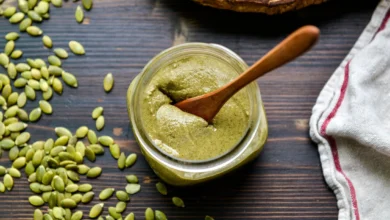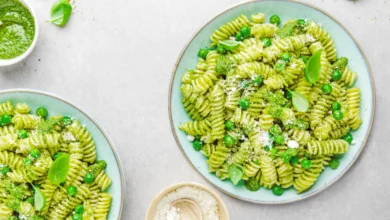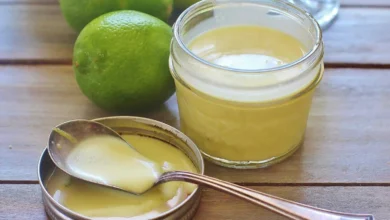
The fresh oregano pesto condiment is a versatile way to elevate any dish. While basil is the more common type of herb used in pesto, oregano pesto offers a strong flavour that is nicely tempered by the other ingredients. As a versatile herb, oregano is often used dried but doesn’t get the same attention when fresh. This recipe showcases just how many tons of flavour oregano can impart when given its day in the sun.
Contents
- Fresh Oregano Pesto
- Fresh Oregano Pesto Recipe
- Ingredients
- Directions
- Notes
- Frequently Asked Questions
- Could dried oregano be used instead of fresh?
- What could I use if I don’t have quite enough oregano?
- Is there another nut I could use instead of walnuts?
- What can I do with a ton of fresh oregano?
- Is fresh oregano better than dried?
- What makes pesto taste better?
- How do you preserve fresh oregano?
- Is it OK to eat fresh oregano leaves?
- Do oregano and basil go together?
Fresh Oregano Pesto
This fresh oregano pesto comes together quickly in the food processor. A bunch of fresh oregano, roughly chopped, forms the base. Roasted Red Pepper Pesto can serve as an example – it is commonly made with red peppers, oregano, olive oil, garlic, and nuts. The same blending of complementary flavours and textures applies here. In addition to the oregano, this pesto includes toasted walnuts, Parmesan cheese, garlic, lemon juice and olive oil. The blend results in a condiment with a wonderfully fresh and balanced flavor profile that is equally at home serving as a dip, spread, pasta sauce or vegetable topping. Its versatility allows it to be enjoyed year-round, providing a bright pop of flavor to lift even the simplest of meals
What You Will Love About This Recipe
If you grow your own oregano in the garden, you know it has the tendency to get crazy prolific. This recipe provides the perfect saving grace for all that abundant fresh oregano. Rather than letting bundles of the herb go to waste or bothering to dry it all, this pesto allows you to capitalize on your harvest and enjoy flavorful meals all year round.
For those who don’t have outdoor garden space or a green thumb, this fresh oregano pesto recipe is still the answer to an important question – how do you keep herbs such as oregano fresh throughout the winter months indoors? By simply blending your fresh oregano harvest into a pesto and freezing portions, you can continue having homemade oregano pesto well past the time period when fresh oregano naturally happens in your area. Drying is one option but results in a markedly different flavor, so this pesto recipe is the garden-fresh solution.
Types Of Oregano
There are a few main varieties of oregano that are more common to run across. The type most often found in the grocery store and called for in traditional Italian recipes is Italian Oregano. With its bright flavor, this variety is perfect for the pesto recipe. Greek Oregano has a more robust, almost spicy taste and is another type commonly used in Mediterranean cuisines like on pizzas and in pastas and sauces.
While those two may be most familiar, there are other varieties worth knowing about too in case you run across them in your own garden or a specialty market. Spanish oregano has notes of sage and cinnamon. Mexican oregano lends flavors reminiscent of anise and licorice. For this versatile pesto recipe , Italian oregano does the trick but feel free to experiment with a touch of whatever fresh oregano variety you have on hand too to find your favorite taste.


Other Oregano Varieties
- Golden Oregano: As the name suggests, this variety has bright yellow leaves rather than green. The flavor is similar to common oregano but more subtly aromatic.
- Marjoram: While technically a separate herb, marjoram is often thought of as a milder, toned down cousin to oregano. It can be used for substituting oregano in a recipe, using an equal amount. Its flavor has hints of spice but not as strong or sharp as oregano.
There are a few other interesting varieties worth noting:
- Syrian Oregano is similar to Greek oregano but has a distinctive flavor profile used in Middle Eastern spice blends like za’atar.
- Other Varieties include Mexican Oregano, Cuban Oregano and true Oregano which are all technically in the same family as common oregano but may have slightly different flavors, uses and geographical origins. In cooking applications they can generally be similar.
What Do I Do with Oregano Pesto?
I always love how versatile homemade pesto can be. Once you have a batch of this fresh oregano pesto in your fridge, the possibilities are endless for sneaking more oregano flavor into meals. Here are some ideas for using up every last bit:
- Toss with hot pasta and top with fresh grated parmesan, extra olive oil and a garlic clove or two
- Slather on grilled pizza before baking or mix into your own pizza sauce
- Stir a few tablespoons into pasta sauces, roasted veggie mixtures or oregano pasta
- Spread on sliced roast potatoes and bake until crispy
- Mix into salad dressings or chicken/ salmon salads
- Use a spoonful or two as a spread for sandwiches or in the A Communal Table creamy pesto gnocchi recipe
- Season lemon chicken skewers or fish with a dollop before roasting in the oven
- Top bruschetta, crostini or pizza with a whipped ricotta and pesto
Troubleshooting:
If you run into any issues with this fresh oregano pesto, don’t fret – pesto’s are usually quite forgiving. Here are a few tips:
- If the herbs seem dry or lacklustre, try sautéing the garlic and oregano in a bit of olive oil before blending. This helps bring out more flavour.
- Having trouble blending to a smooth consistency? Add a tablespoon or two of the sunflower or pumpkin seeds to help it along if nuts aren’t an option.
- For a nut-free vegan version, nutritional yeast can sub in for the parmesan and add creaminess.
- Don’t be afraid to get creative with substituting or blending in other fresh herbs like basil or parsley – it’s fun to experiment! Just be sure everything is cooled before packing in jars.
Ingredients
- Fresh oregano, basil, thyme, parsley – Remove any thick or tough stems before using.
- Pine nuts, walnuts, or pecans – Toast for extra richness and flavour. Toasted will have a softer texture than un-toasted.
- Garlic – Either finely minced fresh or jarred works. Fresh has more potent garlic flavour.
- Parmesan or others aged hard cheeses – Grated Parmesan is classic, but also nice blended are Grana Padano or aged white cheddar for a creamier pesto.
- Olive oil – Use a high quality regular or EVOO. The olive oil carries the flavours.
- Salt and pepper – Season to taste. Freshly ground black pepper adds another layer of complexity.
How to Toast Pine Nuts
Toasting pine nuts takes just an extra 5 minutes but makes a big difference in the finished pesto. It’s the perfect first step while prepping the rest of the ingredients. The toasted nuts blend into an incredibly creamy, rich texture that takes this pesto to heaven.
To do so, add 1/4 cup of raw pine nuts to a dry skillet over medium-high heat. No oil is needed. Continuing tossing and moving the nuts around for 5-7 minutes until they are light golden brown and very fragrant. Don’t leave them unattended or they can burn easily. After toasted, remove from heat and transfer to a plate to cool for at least one minute before proceeding with the rest of the recipe. The slight color and nutty aroma make all the difference in pesto recipes that call for toasted pine nuts.
How to Make Oregano Pesto
- Add the chopped oreqgano, toasted pine nuts, Parmesan, garlic and seasoning to your blender or food processor. Pulse a few times to combine.
- With the motor running, stream in the olive oil through the feed tube in a slow, steady stream. Blend or process until the desired consistency is reached, whether you prefer it completely smooth or leaving a bit of texture. Stop blending according to your personal pesto preference.
Now that your fresh oregano pesto is made, it’s time to enjoy it! The best way is to toss hot cooked pasta with a splash of its cooking water and the pesto in a large skillet over medium-high heat. Cook, stirring frequently, until the pasta is evenly coated and the pesto is warm and has made a glossy sauce. You can stir in halved cherry tomatoes or shredded basil for a pop of color and extra flavour during the last minute of cooking. Transfer the pesto pasta to a serving platter and top with more freshly grated Parmesan cheese to taste while it’s still warm. The cooking process helps bring all the flavours together, so the pesto lightly coats each strand of pasta – it’s simply delicious!
RELATED: Creamy Lemon Spring Pasta Salad Recipe
RELATED: How To Freeze Gnocchi
How to Store Oregano Pesto
To store your homemade oregano pesto, transfer it to an airtight container or sealable jar. It will last up to 5 days when refrigerated. For longer term storage, you can also freeze the pesto for up to 6 months. The ingredients may separate a bit while frozen but don’t fear – it only takes a few minutes to bring everything back together with a quick stir.
If the oil has solidified in the fridge, simply let it sit at room temperature to soften again. Give it a good stir to reincorporate the oil before using. You can also scoop off some of the oil for another use like roasted potatoes if you want a thicker pesto. Properly stored, this fresh pesto will keep your kitchen filled with the aromas of your garden for many more meals to come.
Nutrition
| Nutrient | Amount |
| Calories | 195 kcal |
| Carbohydrates | 9.1 g |
| Protein | 4.4 g |
| Fat | 17.8 g |
| Saturated Fat | 3.2 g |
| Cholesterol | 5 mg |
| Sodium | 164 mg |
| Potassium | 238 mg |
| Fiber | 5.4 g |
| Sugar | 0.7 g |
| Calcium | 354 mg |
| Iron | 1.1 mg |
Variations You Can Try
1- Basil and Oregano Pesto
You can also try making a blended “basil and oregano pesto” by combining both herbs. The sweetness of basil pairs beautifully with the warm spice of oregano. Mix up a batch using equal parts of each herb along with the standard pesto ingredients of olive oil, garlic, pine nuts and Parmesan. Spread this hybrid pesto on bruschetta or use as a dip for veggies. Its pleasantly complex flavour profile makes it a versatile condiment all year round.
2- Basil and Oregano Pesto
You can also experiment with flavour variations, like a “lemon oregano pesto”. Zest a lemon and add the zest along with a squeeze of fresh lemon juice to the food processor when making pesto. The bright citrus notes complement the earthy oregano beautifully. Use this lemony pesto to top grilled chicken or fish. It also adds a refreshing twist when blended into hummus or spread on sandwiches instead of traditional pesto. The subtle lemon boost lifts the flavours of the oregano without overpowering it.
Storing Oregano Pesto
Homemade oregano pesto is best stored in the refrigerator in a tightly sealed container and will last about a week. The garlic and herbs will stay fresher this way. If your pesto thickens up from refrigeration, simply let it sit at room temperature for 30 minutes to soften and then give it a good stir. You may need to stir in a little olive oil if it’s got too stiff.
For those following a vegan diet, it’s also possible to make an “oregano pesto vegan” version by substituting nutritional yeast or soaked raw cashews for the Parmesan and Romano cheeses. For longterm storage of this dairy-free pesto, freezing is recommended. Simply portion the pesto into ice cube trays and once frozen, transfer to an airtight freezer container. This will keep the vegan pesto fresh for 2-3 months. Just thaw overnight in the refrigerator before using.
For Longer Storage:
If you want longer storage, you can simply freeze the pesto. Simply portion it into ice cube trays and freeze. Once frozen, transfer the cubes to a freezer friendly container. Labelled cubes of fresh pesto can be kept in the freezer for up to two months. This makes it easy to pull out just what you need when ready to use. There’s no need to thaw the pesto either – just drop the frozen cubes straight into dishes like soups, stews, or sauces.
To defrost your pesto:
There are a few easy methods to defrost your homemade pesto if keeping it in the freezer. For large batches stored in a freezer-safe container, the safest method is to defrost overnight in the refrigerator. This allows it to thaw gradually without getting too soft. For single servings or cubes, you can also defrost them quickly right before cooking by leaving them on the counter for 30 minutes or using the defrost setting on your microwave. Just be sure not to microwave pesto for too long, as the heat can cause it to separate. Properly defrosted pesto can then be added directly to dishes like pasta or used as a topping.
Fresh Oregano Pesto Recipe
Course: Meals, PastaCuisine: Mediterranean4
servings15
minutes195
kcal15
minutesHere is the recipe ingredients and instructions. You can also print the recipe.
Ingredients
3 cups fresh oregano leaves, lightly packed
1 cup fresh basil leaves
1/3 cup pine nuts
3 cloves garlic, minced
3/4 cup extra virgin olive oil
1/2 cup parmesan, grated
1/4 cup Pecorino Romano cheese, grated
Salt and pepper to taste
Directions
- Add the oregano, basil, pine nuts, garlic, salt and pepper to a food processor. Pulse until roughly chopped.
- Turn on the processor and slowly add the olive oil through the feed tube with the machine running. Process until a thick, smooth paste forms.
- Turn off the processor and scrape down the sides. Add the parmesan and pecorino cheeses. Process just until incorporated.
- Taste and adjust seasoning as needed. Transfer to an airtight container. Refrigerate for up to 1 week.
Notes
- Toss warm cooked pasta with pesto for a fresh and easy dinner. The pesto also makes a delicious spread on flatbread or bruschetta. Enjoy!
Conclusion
Homemade fresh oregano pesto is a versatile and flavorful condiment to have on hand. With its vibrant green color and warm, aromatic herb flavor, it enlivens so many dishes from pastas to sandwiches. Experimenting with different fresh herb combinations also allows for endless variety. Most importantly, making your own pesto ensures you always have access to that bright zing of fresh Mediterranean flavors.
Frequently Asked Questions
Could dried oregano be used instead of fresh?
While dried oregano adds flavour, this pesto recipe needs the bright, fresh green leaves of fresh oregano for texture and peak flavour. Dried oregano will result in a pesto with a much more subdued flavour.
What could I use if I don’t have quite enough oregano?
If short on fresh oregano, arugula or marjoram can stand in to contribute fresh herb flavour to the pesto batch. Or use a small amount of basil as a flavourful filler.
Is there another nut I could use instead of walnuts?
Pine nuts are a classic pesto nut but almonds or walnuts also work well if you can’t eat pine nuts. Even pumpkin or sunflower seeds would be a tasty alternative.
oregano pesto without nuts:
For those wanting a nut-free pesto, you can easily make an oregano pesto without nuts. Simply leave the pine nuts or other nuts out of the recipe. The fresh herb, garlic and olive oil flavors will still shine through. You may need to adjust the consistency by adding a bit more oil or even toasted breadcrumbs. Experiment with different fillers to find your preferred texture. This nut-free version is a great option for those with allergies or dietary preferences
What can I do with a ton of fresh oregano?
Make multiple batches of garlic oregano pesto to freeze! It’s perfect for adding bold flavours to grilled foods like chicken or fish. The pesto also makes a delicious pasta sauce or topping.
Is fresh oregano better than dried?
Dried oregano has a sharper, more peppery flavour compared to fresh, which is milder and more balanced. For most dishes, dried stuff works well sprinkled on pizza, in breading or eggplant Parm. But pestos require the bright flavour of fresh herbs.
What makes pesto taste better?
A balanced mixture of the fresh flavours – fragrant basil, pungent garlic, buttery olive oil combined with sweet pine nuts or tangy cheese – is what makes pesto taste zingy rather than muddy. Be sure each component remains identifiable.
How do you preserve fresh oregano?
To preserve fresh oregano, roll the herbs in a damp paper towel and seal in a Glad Zipper Bag in the crisper drawer of the refrigerator. It will stay fresh for a week.
Is it OK to eat fresh oregano leaves?
Oregano leaves are safe to eat in foods, as it takes reliable information, oregano has mild side effects in amounts normally found in food like stomach upset. As with any herb, moderation is best.
Do oregano and basil go together?
Oregano, with its warm, pungent, lemon-like aroma, pairs beautifully with many classic basil in pestos. The two complement each other and other common fresh herbs like parsley, sage, mint, and thyme.




